wrestling / Columns
The Magnificent Seven: The Top 7 Short-Lived Tag Teams
Tag teams have come in and out of vogue in mainstream American wrestling. I’ve always had a soft spot for particularly well-aligned duos in which the whole is greater than the sum of its parts. Combinations like The Road Warriors, The New Age Outlaws, and The Rock and Roll Express for which the component pieces of teams could never attain the level of success as singles performers that the pair achieved as a team.
Each of the aforementioned teams got at least one prolonged run in the spotlight. Other teams haven’t been so fortunate. Whether it was questionable booking, injuries, suspensions, or ill-timed departures from a promotion, these teams showed promise but never quite achieved the magnitude of success they probably should have.
I’ll be the first to admit that the term “short-lived” is a bit ambiguous and arbitrary in this context, but as a general guideline I’m looking at teams that had a lot of promise, but got well under a year to fully realize their potential. Without further ado, I present the top seven short-lived tag teams.
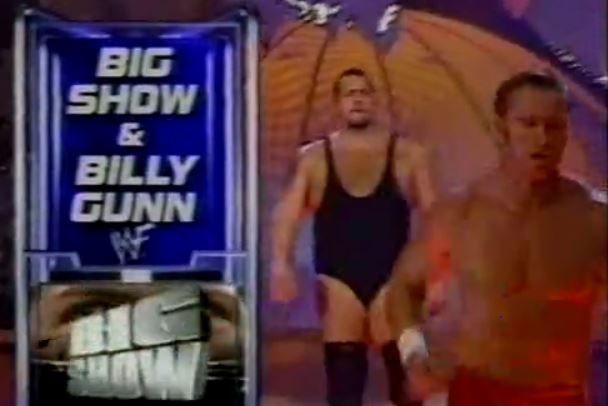
#7. Show Gunns
I’m fairly confident that this will be the least popular selection on this countdown, and I get it. The tandem of Billy Gunn and the Big Show didn’t accomplish much and weren’t afforded enough time to meaningfully gel as a team. Moreover, critics are completely within their rights to suggest that this was an instance of the WWF throwing together two directionless guys in hopes they might figure out something meaningful to do together.
I count Show Gunns on this list because of the potential the team had. For all of his opportunities at the main event level, and his arguable successes I don’t know that Show was ever better than a plan B or placeholder for truer top-level superstars at the head of the card, and I’ve always felt that he was at his best as part of a team–the muscle and credibility behind Chris Jericho’s mic skills and athleticism in Jerishow and an imposing enough force to make his teams with The Undertaker and Kane impossible to ignore.
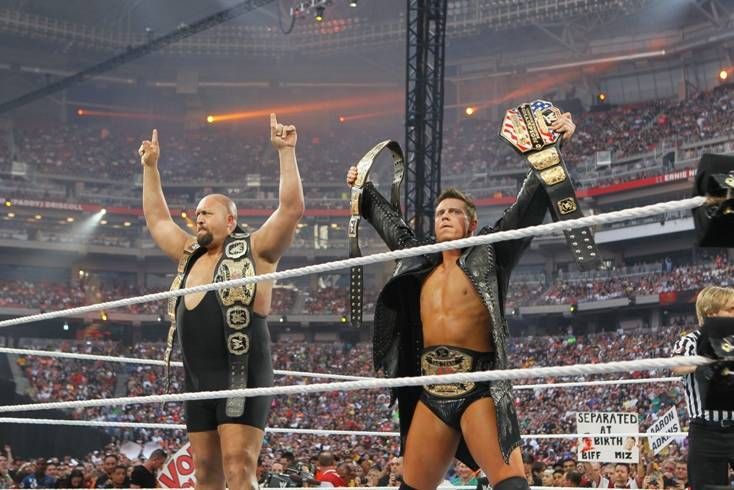
#6. ShoMiz
I said I liked The Big Show in tag teams, didn’t I? The teaming of The Big Show and Miz was a bit of a stop gap between JeriShow and The Miz ascending to the main event. The two represented many of the same qualities as JeriShow, though arguably not as strongly, as Miz, at his best, matched Jericho on the mic, and never was quite the workhorse Y2J could be. Just the same, Miz did draw legit heat, and pairing him with Big Show lent him additional credibility and a big body to hide behind when he had run his mouth a bit too aggressively. The two had a good little program with MVP and Mark Henry, and solid if under-realized WrestleMania opening bout with R-Truth and John Morrison, before dropping the straps to The Hart Dynasty, after which Show turned face and Miz readied himself for arguably his best feud opposite Daniel Bryan, and then cashed in Money in the Bank to start the next chapter of his career in earnest.
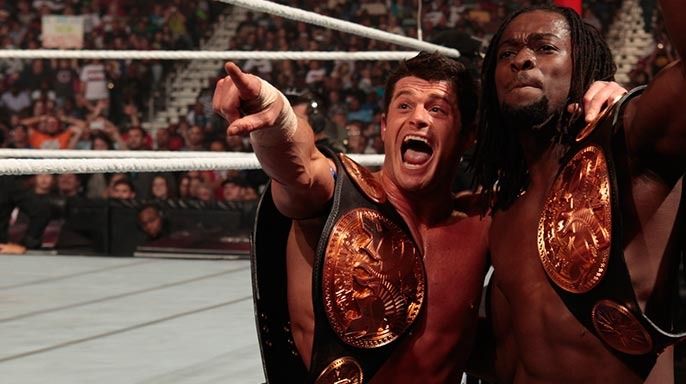
#5. Air Boom
While Show Gunns and ShoMiz each could have accomplished more with more time, I won’t deny that the pairings had shelf lives. To the contrary, I’d contend that Air Boom–the pairing of Kofi Kingston and Evan Bourne–might have arrived in the pantheon of legitimately great tag teams had they stuck together longer. Moreover, I’d argue that the potential they had as a team far exceeded what either of them had or will achieve individually. The two went a long way toward revitalizing the WWE tag division in its 2011 doldrums, putting together a very fun high-flying tandem that relieved the underachieving Michael McGillicutty and David Otunga of the straps and went on to have good matches opposite R-Truth and The Miz, Jack Swagger and Dolph Ziggler, and Primo and Epico. I’m skeptical that Primo and Epico ultimately taking the titles was ever WWE’s original plan, but Bourne had not one, but two ill-timed wellness violations, which gave way to his suspension and eventual termination from WWE. His departure left Kingston to flounder in partnership with R-Truth, and then as a largely directionless mid-carder for years to follow.

#4. Cactus Jack and Kevin Sullivan
The tag team partners who don’t really get along angle has been done to death, but the pairing of Cactus Jack and Kevin Sullivan 1994 WCW put an entertaining spin on the theme. The guys didn’t so much feud with one another as play the parts of crazed sociopaths ready to fight anyone they crossed paths with, including opponents and each other. The team was probably a placeholder for each man, as Sullivan was booked to team with his kayfabe brother Dave Sullivan before The Equalizer got injured, and Jack was on his way out the door after a pretty hot tag run with Maxx Payne, and didn’t have much of anything else to do. The two combined forces to feud with The Nasty Boys over the tag titles in a wonderfully violent little program, and promptly set to feuding with each other as soon as they had dropped the titles.
The end decision for Jack and Sullivan to feud with each other was the right call, and the brief program’s culminating Loser Leaves WCW match was a great destination. Just the same, had Mick Foley’s contract run a half year longer, I suspect that this tag team could have done all the more to keep the WCW tag division lively and colorful with off-beat brawls to balance the more cartoon-ish aspects of WCW that were on their way in when Hulk Hogan came to town. Instead, Foley went on to star in ECW before his career-defining run in WWE, while Sullivan became a cartoon-ish, over-matched, de facto arch nemesis for The Hulkster.
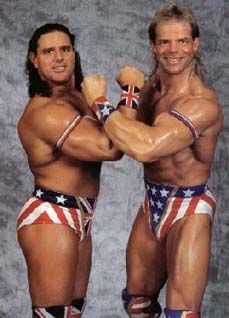
#3. The Allied Powers
Lex Luger and Davey Boy Smith are something like kindred spirits in the world of professional wrestling. They’re a pair of musclebound talents, Luger with more charisma and star power, Smith with more athletic ability and objective wrestling skill, each of whom felt like they probably should have been main eventers, neither of whom ever truly thrived in that role.
The year was 1995, and the experiment of Luger as Hulk Hogan 2.0 had officially come up short. After a main event run opposite Yokozuna and Ludvig Borga, Luger had settled into an upper mid-card feud with Ted Dibiase’s Million Dollar Corporation and, by WrestleMania 11, had pretty thoroughly stomped out that threat. Smith was recently returned from a WCW run that had nominally pushed him from upper mid-carder to fringe main eventer. For lack of anything better to do, the two paired up for a team with a fantastic look, fun name, and a pretty clear path toward feuding with new tag champs, Owen Hart and Yokozuna in a program that I’ve always suspected would have been quite good and done more for the tag division than the Two Dudes with Attitudes multi-belt cluster that ensued. History wasn’t on this pairing’s side, though. Shortly after squashing The Blu Brothers at ‘Mania, Luger jumped ship to WCW and the pairing never came together again. Smith’s heel turn was accelerated–I suspect the WWF intended a slow burn resentment for the crowd chanting USA during his matches, and an eventual turn on Luger to keep the two of them occupied and ease Smith into the main event. Instead, Smith abruptly went bad, joined Camp Cornette, and never really got over at the main event level.
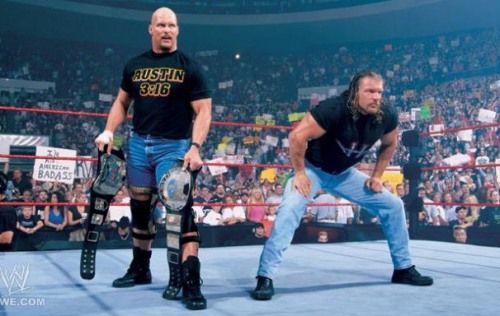
#2. The Two Man Power Trip
The general consensus is that turning Steve Austin heel at WrestleMania 17 was a mistake. The crowd never could bring itself to hate Stone Cold, the turn killed his top face momentum, and the whole ordeal ended up at the forefront of an underwhelming Alliance vs. WWF angle.
In defense of the heel Austinangle, though, everything may have played out differently had Triple H not gotten hurt.
In the early days of the turn, Triple H aligned himself with Steve Austin and the long-time rivals became an overwhelming heel force. By most reports, the two were planned to team for an extended run before Trips gradually turned face and challenged Austin at or before WrestleMania 18. The plan got off to a reasonable enough start with Austin and Helmesley squaring off with teams including The Brothers of Destruction, The Hardy Boyz, and Chris Jericho and Chris Benoit.
The brilliance of the Two-Man Power Trip was that the duo had enough credibility between them to believably face off against any pair, but just the same, there was a built in excuse for a really good team to beat them, in that they were still learning to work as a unit, and thus a long-time pairing like Matt and Jeff Hardy could steal a win because they were so in sync with one another.
Long story short, the angle had legs, and held the promise of many good, high profile tag matches, and a culminating feud that probably would have been significantly more satisfying that Triple H challenging Chris Jericho for the title and Austin aimlessly brawling with Scott Hall at ‘Mania.
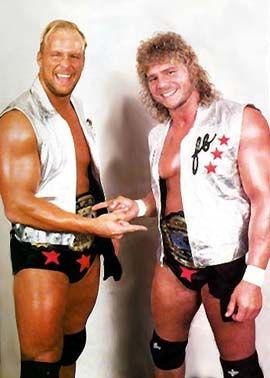
#1. The Hollywood Blonds
The story is well-known. Steve Austin thought himself to be on the verge of a major singles push in WCW, only to find out that, instead, he was going to be paired in a tag team with Brian Pillman. He begrudgingly went along with it and, after a few months of working together, the team got more over than anyone ever expected or really intended for them to. So, WCW broke them up without any meaningful plans for their singles careers to follow.
To be fair, the pairing of Stunning Steve Austin and Flyin’ Brian Pillman did get almost ten months to come to fruition–longer than any other team on the countdown. That said, it’s criminal that a team with such chemistry and skill, and for which the performers didn’t have other clear directions, didn’t get longer to see just how far they could go. Sure, the guys were likely to be shunted down the card a bit when Hulk Hogan and company showed up the following year and dispatched the homegrown talents. Just the same, at the risk of being overly optimistic, I don’t think it’s unrealistic to suggest the tandem might have ascended to fringe main event level as a unit had they been given another six months to get their act over even further.
Instead, Austin would flounder in the mid-card and get released a little over a year after the team split. Pillman would espouse an insane gimmick in which reality and fiction blended, and he left the company, visited ECW, and finished up his days with the WWF, where his rivalry with Steve Austin would be a key early milestone for the Attitude Era. WCW’s loss was ultimately the WWF’s gain, and things obviously turned out just fine for Austin. Nonetheless, splitting the Blonds too early remains one of wrestling’s great missed opportunities.
What were your favorite short-lived tag teams? Let us know what you think in the comments section. See you in seven.
Read stories and miscellaneous criticism from Mike Chin at his website and his thoughts on a cappella music at The A Cappella Blog. Follow him on Twitter @miketchin.
More Trending Stories
- Kevin Nash Comments On ‘Antiquated’ Oklahoma State Athletic Commission, Thinks Recent Nyla Rose Ruling Was Political
- Eric Bischoff Thinks Tony Khan Should Bring In Jinder Mahal To AEW
- Booker T On Swerve Strickland’s AEW Title Win, Says Goldberg Wouldn’t Fit There
- The Undertaker on Why Triple H Was Right About Outside Stars Struggling in WWE







